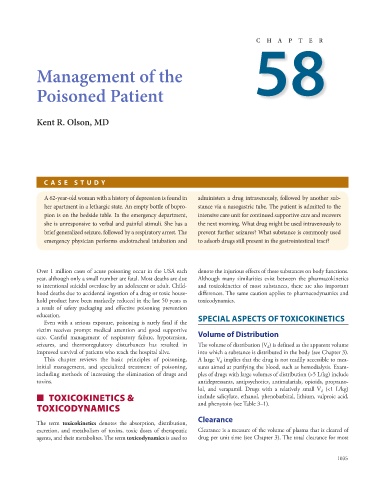Page 1049 - Basic _ Clinical Pharmacology ( PDFDrive )
P. 1049
58
A
P
C
H
T
R
E
Management of the
Poisoned Patient
Kent R. Olson, MD
C ASE STUD Y
A 62-year-old woman with a history of depression is found in administers a drug intravenously, followed by another sub-
her apartment in a lethargic state. An empty bottle of bupro- stance via a nasogastric tube. The patient is admitted to the
pion is on the bedside table. In the emergency department, intensive care unit for continued supportive care and recovers
she is unresponsive to verbal and painful stimuli. She has a the next morning. What drug might be used intravenously to
brief generalized seizure, followed by a respiratory arrest. The prevent further seizures? What substance is commonly used
emergency physician performs endotracheal intubation and to adsorb drugs still present in the gastrointestinal tract?
Over 1 million cases of acute poisoning occur in the USA each denote the injurious effects of these substances on body functions.
year, although only a small number are fatal. Most deaths are due Although many similarities exist between the pharmacokinetics
to intentional suicidal overdose by an adolescent or adult. Child- and toxicokinetics of most substances, there are also important
hood deaths due to accidental ingestion of a drug or toxic house- differences. The same caution applies to pharmacodynamics and
hold product have been markedly reduced in the last 50 years as toxicodynamics.
a result of safety packaging and effective poisoning prevention
education. SPECIAL ASPECTS OF TOXICOKINETICS
Even with a serious exposure, poisoning is rarely fatal if the
victim receives prompt medical attention and good supportive
care. Careful management of respiratory failure, hypotension, Volume of Distribution
seizures, and thermoregulatory disturbances has resulted in The volume of distribution (V ) is defined as the apparent volume
d
improved survival of patients who reach the hospital alive. into which a substance is distributed in the body (see Chapter 3).
This chapter reviews the basic principles of poisoning, A large V implies that the drug is not readily accessible to mea-
d
initial management, and specialized treatment of poisoning, sures aimed at purifying the blood, such as hemodialysis. Exam-
including methods of increasing the elimination of drugs and ples of drugs with large volumes of distribution (>5 L/kg) include
toxins. antidepressants, antipsychotics, antimalarials, opioids, proprano-
lol, and verapamil. Drugs with a relatively small V (<1 L/kg)
d
■ TOXICOKINETICS & include salicylate, ethanol, phenobarbital, lithium, valproic acid,
TOXICODYNAMICS and phenytoin (see Table 3–1).
Clearance
The term toxicokinetics denotes the absorption, distribution,
excretion, and metabolism of toxins, toxic doses of therapeutic Clearance is a measure of the volume of plasma that is cleared of
agents, and their metabolites. The term toxicodynamics is used to drug per unit time (see Chapter 3). The total clearance for most
1035

